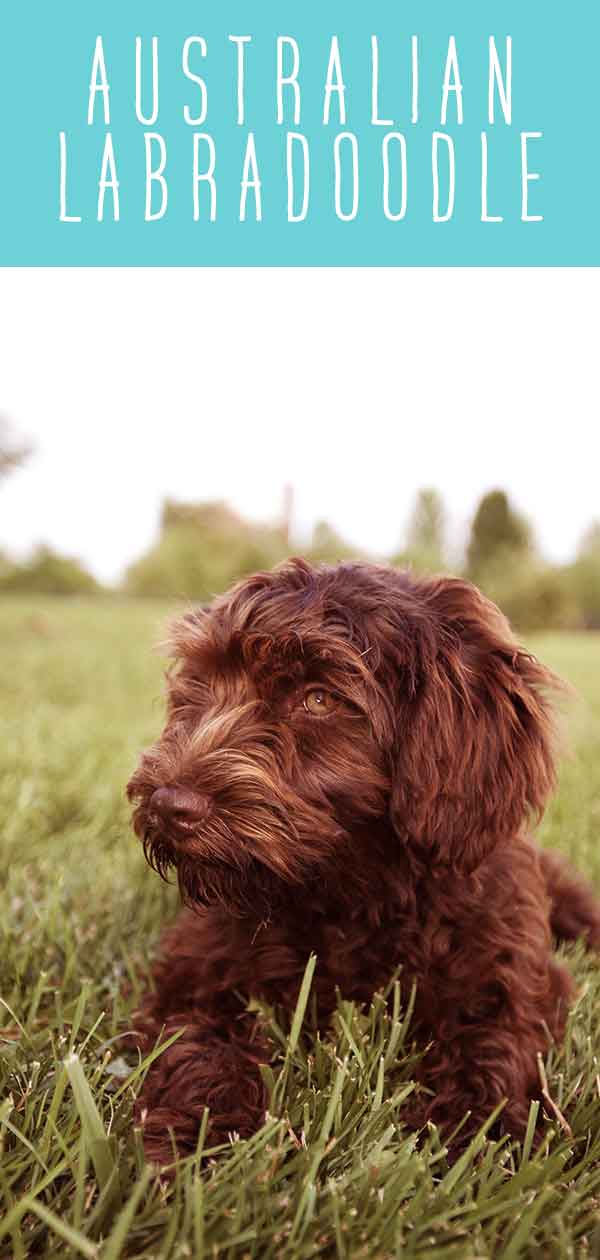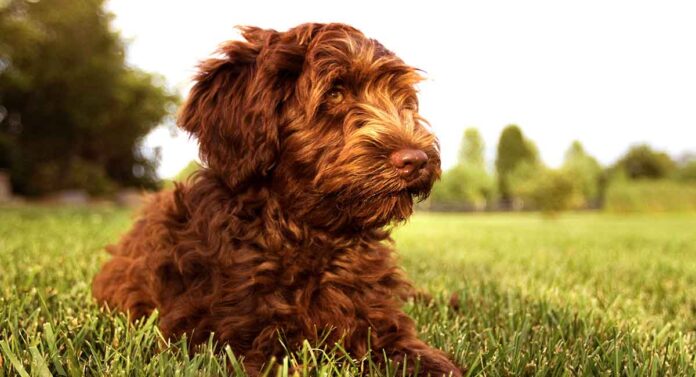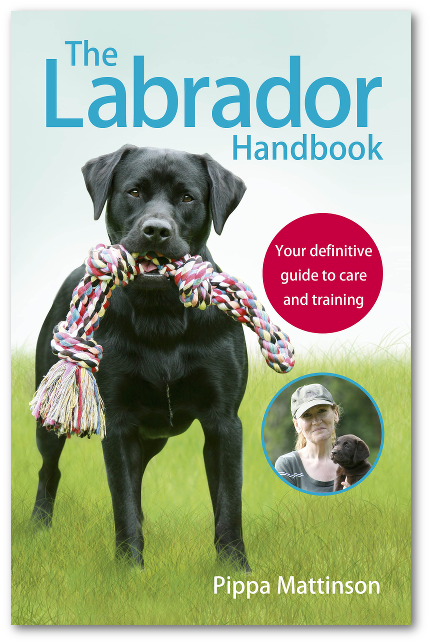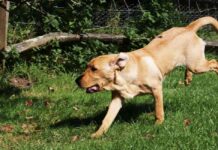The Australian Labradoodle is a mixed dog breed, with Labrador, Poodle, English and American Cocker Spaniel, Curly Coated Retriever, and Irish Water Spaniel ancestors.
The aim of the Australian Labradoodle was to produce a new purebred with its own breed standard and with predictable traits than a first-generation Labrador Poodle cross.
Your adult Australian Labradoodle dog will be loyal, energetic, friendly and fun. They have long noses and curly fur coats, that come in a range of colors and patterns. Your dog’s fur will be low shedding and mild allergy friendly, as the curls catch lose dander and hairs.
- Labradoodle vs Australian Labradoodle
- Coats, colors and grooming
- Temperament and training
- Are they healthy pets?
Today you’ll discover the pros and cons of the Australian Labradoodle. You’ll learn where to find Australian Labradoodle breeders, and how to raise and care for your growing Australian Labradoodle puppy. Focussing on their personality and behavior, as well as their socialization and training needs. You will get to grips with the difference is between the Labradoodle and Australian Labradoodle, and feel confident which adult dog is a better fit for your lifestyle.
Where Do Australian Labradoodles Come From?
The term ‘Labradoodle’ was first coined back in 1955. But, the name—and the dog itself—did not become popular until several decades later. In the 1980s, Wally Conran, a breeding manager for Australian Guide Dog Services, found himself faced with a challenge.
A client needed a guide dog but also suffered from terrible allergies to dogs. Labradors have long been used as guide dogs, mainly owing to their gentle nature. But they are certainly not hypoallergenic. The curly coat of the Poodle does ‘catch’ some of the loose hairs and dander that are responsible for allergies. So, for some people, that means fewer allergies.
Australian Labradoodle vs Labradoodle
A Labradoodle born down under does not automatically qualify as an ‘Australian Labradoodle’! There are significant differences between the Labradoodle and Australian Labradoodle.
Labradoodles have one Labrador parent and one Poodle parent. Australian Labradoodles can be a blend of up to six different breeds:
- Labrador
- Poodle
- Cocker Spaniel
- American Cocker Spaniel
- Curly Coated Retriever
- Irish Water Spaniel.
Australian Labradoodle Breeds
These breeds are selectively mixed together to create a dog with a winning temperament. But also with a low-shedding coat.
Australian Labradoodles have been bred this way since the 1980s. Even now, breeders are striving to make a consistent set of breed-specific traits. They hope these can be reliably passed down from one generation to the next. And that’s why Australian Labradoodles have far more predictable traits. The breed standard was introduced in 1997.
Fun Fact!
The Royal Guide Dogs (Wally Conran worked for these guys) bred 31 of these original Labradoodles. And of those 31, 29 became guide dogs. Pretty impressive for the first-ever batch of this brand-new mix. Don’t you think?
Australian Labradoodle Size
Your full grown Australian Labradoodle can reach around 24 inches tall and weigh about 77 lbs. This will be slightly more for males on average than for females.
Doodle Coats and Colors
They can have one of two coat types. Either fleece-textured or wool-textured. They are often described as teddy bear-like. And this certainly adds to their appeal!
- Fleece-textured coats are soft and either straight or wavy. They can also have spiral-shaped curls.
- Wool-textured coats feel—you guessed it!—like wool! And they’re usually curly.
There are loads of different Australian Labradoodle colors! Some of the most popular include black, red, white, apricot, caramel and even parti patterns.
Grooming
Whether your Australian Labradoodle has a fleece- or wool-textured coat, they will need weekly brushing. You might find it useful to enlist a professional groomer. They can trim your pup’s coat two or three times a year. When grooming, check your pup’s eyes, ears and nails too.
Australian Labradoodle Temperament
Australian Labradoodles are gentle, loyal, and sociable. They are not aggressive and are very good with children. Plus, they are intelligent and quick to learn.
Naturally playful, they enjoy time with their human families. But they should not be left alone or in crates for too long. Also, Australian Labradoodles are active dogs. Your dog will need over an hour of daily activity.
Positive Training Methods
Australian Labradoodles are often described as ‘born to serve.’ This means that they’re naturally quick to learn. And as a result, relatively easy to train. But, it’s very important to begin training and socialization early in your puppy’s life.
Socialization can have a huge impact on your puppy’s development. And puppies that are socialized early are less likely to display behavioral problems later on.
Research shows that positive, rewards-based training is more effective than punishment-based training. In fact, punishments negatively affect behavior. But rewards-based training actually improves your dog’s ability to learn.
When using rewards to train your pup, make sure you include any edible treats as part of your pup’s daily food allowance. This will help prevent weight problems.
Australian Labradoodle Health
Hybrid vigor suggests mixed-breed dogs experience fewer inherited disorders than their purebred counterparts.
The limited gene pools of purebreds can cause a number of health-related issues. This is due to years of inbreeding. But, this doesn’t mean mixed breeds are entirely free from the same inherited conditions. They may still inherit certain health conditions from either parent. So, if you’re considering an Australian Labradoodle, you should be aware of the potential health concerns.
Parents should have good hip and elbow scores, a recent clear eye test and and a clear screening for the bleeding disorder Von Willebrand’s.
Is the Australian Labradoodle Right For Me?
An Australian Labradoodle is a great fit if you have children or other pets. Or if you’re looking simply for a gentle companion that gets along with anyone. They tend to be calmer than the standard Labradoodle. Plus, they’re quick learners.
Early socialization and consistent rewards-based training will help your Australian Labradoodle become a great people-pleaser. But, if you work away from home for long hours, this pup may not be the best choice.

References
- Australian Labradoodle Association of America
- Hiby EF, Rooney NJ, and Bradshaw JWS. 2004. Dog training methods: their use, effectiveness and interaction with behavior and welfare. Animal Welfare.
- Howell TJ, King T, and Bennett PC. 2015. Puppy parties and beyond: the role of early age socialization practices on adult dog behavior. Veterinary Medicine: Research and Reports.
- Oliver JAC and Gould DJ. 2012. Survey of ophthalmic abnormalities in the labradoodle in the UK. Veterinary Record.
- Rooney NJ and Cowan S. 2011. Training methods and owner-dog interactions: Links with dog behavior and learning ability. Applied Animal Behavior Science.
The Labrador Site Founder
Pippa Mattinson is the best selling author of The Happy Puppy Handbook, the Labrador Handbook, Choosing The Perfect Puppy, and Total Recall.
She is also the founder of the Gundog Trust and the Dogsnet Online Training Program
Pippa's online training courses were launched in 2019 and you can find the latest course dates on the Dogsnet website




















I rescued a australian labradoodle who had been used for breeding and had not left her kennel since birth four and a half years earlier. She has the sweetest nature, but was very nervous understandably for a long time especially with men. However she is now happy to great everyone, although she does have funny little ways. She has absolutely no prey drive at all, which is wonderful as I live in the country. I only wish I had had her from a pup.
I think there’s difference between “Aussiedoodles” and “Australian Labradoodles”.
Thanks for the helpful information. Our Australian Labradoodle is a rescue although rescue may not be the correct word, re-homed perhaps as we did pay the previous owner a few hundred dollars for her. We were looking for a medium-sized dog and came upon an ad on Craigslist, with a picture of a large fully grown dog. The ad said they were looking for a new home for their Australian Labradoodle, that was now over 2-years old. The ad said parents worked a lot and teenagers spent less that 5 minutes a day with the dog. A dog run was created in their yard, where she spent her days and she was crated when in the house as she was too hard to handle, kept jumping on them and barking, etc. They said she was not trained much and couldn’t be walked often because she was too strong, pulling too much. Our hearts went out to this rather raggedy-looking dog. Although she was not exactly what we were looking for; when is anything exactly what is wanted? When we went to see her, we saw the family was fairly small in size and she was not totally comfortable on the leash. Fearing she might not be long for the planet if she was to the point of being an untrainable nuisance, we decided to take a chance. We have had her for 5 months now and have made a few mistakes along the way. She is a wonderful dog and we could not imagine being without her. Last but not least, she is quite trainable and even tries to communicate her needs. She gets over 90-minutes plus exercise most days and loves playing fetch. Our last large dog was a Shepsky and died in 2011. She was a rescue we adopted from the animal shelter when she was 16 months old. She was much loved and was almost 17-years old when she died and left us with great memories. I hope our Aussiedoodle has a long full life with us.
The colors of Goldendoodles do not come from the Golden Retriever. They come from the Poodle: black, white, apricot, gray (blue), champagne, red, tan, merle and phantom (light patches of various mixed colors).
Ruthie, our 4 month old apricot/red Australian Labradoodle is amazing! She was one of seven. Smaller than the others. Giving her “chew stuff” I would monitor her by taking it from her, inspecting, then, if appropriate, give it back. Well, this time, she ran and wanted to hide. I knelt at the spot where she ran from, watching her from a distance. She looked at me and came back to where I knelt and allowed me without a fuss to inspect the treat and gave it back to her. Very sweet, submissive and smart!
It’s good to know that Aussiedoodle puppies are known to be quite gentle. I’m planning to adopt one because my daughter has been wanting a pet ever since she was old enough to watch cartoons. Having a gentle pet would make me worry less about unnecessary barking at home.